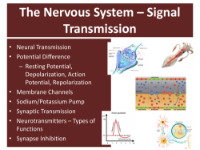2-Minute Neuroscience: Sodium-Potassium Pump
Video
Science
+1
Science
11th Grade - 12th Grade
Premium

N
Neuroscientifically Challenged
Science Resource Description
The sodium-potassium pump is a protein pump that is critically important to the function of neurons. It helps to stabilize membrane potential, and thus is essential in creating the conditions necessary for the firing of action potentials. In this video, I discuss the general function of the sodium-potassium pump.
For an article (on my website) explaining the sodium-potassium pump, click this link: https://neuroscientificallychallenged.com/posts/know-your-brain-sodium-potassium-pump
TRANSCRIPT:
The sodium-potassium pump is a protein pump found in the cell membrane of all animal cells. Its main function is to transport sodium ions out of the cell and potassium ions into the cell. This serves a number of purposes, but is critically important to the function of neurons as it helps to maintain a higher concentration of sodium ions outside the cell, and a higher concentration of potassium ions inside the cell. Preserving these differences in ion concentrations helps to stabilize the cell’s membrane potential. This is critical for the neuron to be able to fire an action potential, which is the basis of the electrical signaling of neurons.
The sodium-potassium pump is a large membrane-associated enzyme that uses the energy of adenosine triphosphate, or ATP, to transport sodium and potassium ions across the cell membrane. All of the details of how this is achieved are not yet fully clear, but the general process involves the binding of ATP to the pump, which promotes the binding of 3 sodium ions and the release of 2 previously bound potassium ions. ATP is broken down and transfers a chemical group known as a phosphate group to the pump, which prompts the pump to undergo a conformational change, or a change in its shape. This causes the bound sodium ions to be released into the extracellular fluid. At the same time, the pump binds 2 potassium ions, which also prompts another conformational change that returns the pump to its previous configuration and the cycle begins again. Each cycle of the pump causes 3 sodium ions to move out of the cell and 2 potassium ions to move into the cell. Because there is one more positive charge leaving the cell than entering, there is a net loss of positive ions, which makes the resting membrane potential of the cell slightly more negative.
References:
Mordecai PB, Yao JPY, Matteson DR. Cellular Physiology and Neurophysiology. 4th ed. St. Louis, MO. Elsevier; 2020.
Purves D, Augustine GJ, Fitzpatrick D, Hall WC, Lamantia AS, Mooney RD, Platt ML, White LE, eds. Neuroscience. 6th ed. New York. Sinauer Associates; 2018.
Thanks to Nicole Lookfong for help with fact-checking the script for this video.
Explore other content in this scheme
Part of a lesson by Teach with Fergy
Other resources in this lesson

2-Minute Neuroscience: Synaptic Transmission
Resource
Science
+1
11th Grade - 12th Grade

The Schwann Cell and Action Potential
Resource
Science
+1
11th Grade - 12th Grade

Action Potential in the Neuron
Resource
Science
+1
11th Grade - 12th Grade

2-Minute Neuroscience: Neurotransmitter Release
Resource
Science
+1
11th Grade - 12th Grade

The Chemical Mind: Crash Course Psychology #3
Resource
Science
+1
11th Grade - 12th Grade

The Nervous System - Signal Transmission - Exit Ticket
Resource
Science
+1
11th Grade - 12th Grade

The Nervous System - Signal Transmission - Student Lesson Outline
Resource
Science
+1
11th Grade - 12th Grade

The Nervous System - Signal Transmission - Student Presentation
Resource
Science
+1
11th Grade - 12th Grade

The Nervous System - Signal Transmission - Teaching Presentation
Resource
Science
+1
11th Grade - 12th Grade
